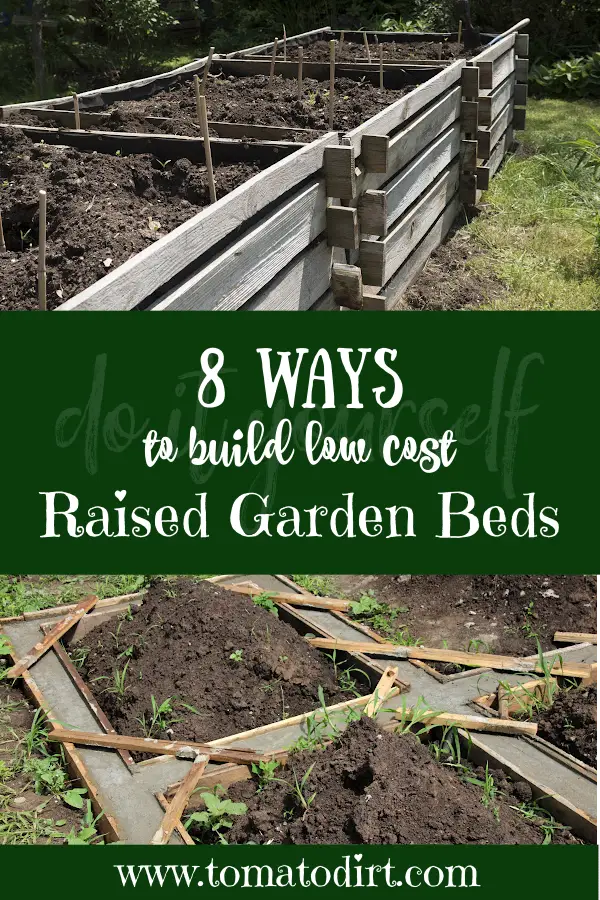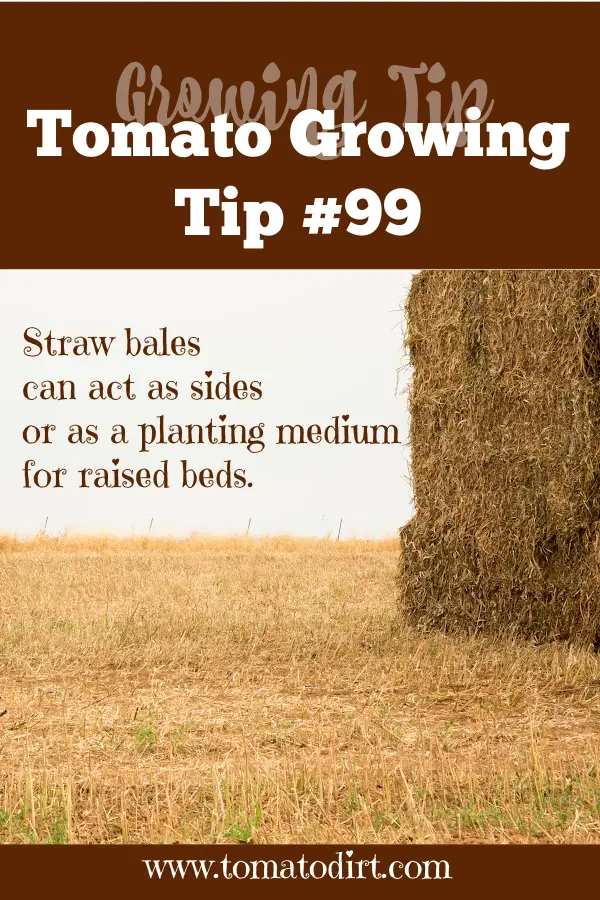FREE: 10 Must-Know Tomato Growing Tips Get The Guide
Read our affiliate disclosure here.
8 Ways To Build Low Cost Raised Garden Beds
Since 2010, Tomato Dirt has garnered 4.8+ million views, making it the web’s leading online source for growing tomatoes in the home garden. Award-winning writer and Tomato Dirt owner Kathy Widenhouse has helped thousands of home gardeners grow healthier tomatoes. Be one of them when you get Tomato Dirt’s Growing Guide here.
Posted 1.18.25
Creating low cost raised garden beds can be simple and affordable.
Raised garden bed kits are convenient, but they can be expensive. Plus, with a kit, you’re limited to the available sizes and designs.
You can build your own raised garden beds with materials you already have or can find cheaply.
Plus, you can design a low cost raised garden bed to fit your space, specific dimensions, and aesthetic preferences. And when you DIY raised beds, you have control over the materials. You can make sure your garden beds are safe for growing edible plants – say, when you use untreated wood or natural stone – and suited to your climate.
Make raised garden beds yourself and you can experiment with unique designs -- even salvage materials you already have – to add a personal touch.
The trick to building low cost raised garden beds is to use readily available or recycled materials. The rest is just sweat equity. Here are some budget-friendly options for building raised beds.
8 low cost raised garden beds you can DIY for cheap
1. Recycled wood pallets
- Cost: Often free from local businesses.
- How: Disassemble the pallets and use the slats to form the walls of the raised bed. Pallets are typically untreated, making them safe for gardening.
- Instructions: Line your raised bed garden edges with pallet wood, attach with screws or nails, and reinforce corners with scrap wood for stability.
2. Cinder blocks or bricks
- Cost: $1–$2 per block (or free if reused).
- How: Stack cinder blocks or bricks to create a rectangular bed. No tools are required.
- Instructions: Lay out your bed shape and stack blocks 2-3 high. For more planting space, fill the holes in the cinder blocks with soil. Use them for companion herbs or flowers next to your tomato plants – or to plant trailing perennials that cover the blocks.
3. Corrugated metal with a wooden frame
- Cost: Around $20–$50.
- How: Combine corrugated metal sheets (often available at hardware stores) with a wooden frame.
- Instructions: Build a simple wooden frame, then screw the metal sheets to the inside of the frame to form the walls. You’ll create durable, rustic-look raised garden beds for cheap.
4. Old tires
- Cost: Free or cheap from local tire shops.
- How: Stack 1-2 old tires and fill them with soil to create a compact raised bed.
- Instructions: Place the tire on the ground, fill it with soil, and plant tomatoes directly in the tire bed. This method is ideal if you don’t have a lot of room or if you want to grow just one or two tomato plants. Plus, the tires act as supports so you won’t need to stake your plants.
5. Logs or fallen branches
- Cost: Free – and a great way to use logs and branches that fall off your trees (and neighbors’ trees) during storms.
- How: Arrange logs or large branches into a rectangular or circular shape.
- Instructions: Stack logs securely and fill the middle with soil. Logs decompose over time, enriching the soil, making this a permaculture-inspired option.
6. Straw bales
- Cost: $5–$10 per bale.
- How: Use straw bales as both the structure and growing medium.
- Instructions: Arrange bales in the shape of your bed, hollow out some of the center, fill with compost, and plant directly into the bales. Straw bales act as mulch. Plus, they decompose over time to make nutrient-rich soil.
7. Plastic storage
tubs or crates
- Cost: $5–$15 per tub (or free if reused).
- How: Repurpose old storage tubs or crates by drilling drainage holes in the bottom.
- Instructions: Fill the containers with soil and arrange them in your preferred configuration. If you want the arrangement to be more secure, you can partially sink the containers into the ground. You can also use as portable raised beds, much like tomatoes in pots, for small spaces like patios or balconies.
8. Reclaimed lumber or scrap wood
- Cost: Free or low cost from construction sites, salvage yards, online neighborhood exchange groups, or Craigslist.
- How: Gather old or scrap wood to build a simple rectangular frame for the bed.
- Instructions: Cut the wood to size, assemble the frame with nails or screws, and fill it with soil. Be cautious of treated lumber, as chemicals may leach into the soil.
More tips for building low cost raised garden beds
- Use locally sourced materials. Check out construction sites, neighbors, and local businesses for free or discounted wood, pallets, or cinder blocks.
- Avoid spending money on expensive soil. Mix your own soil with compost, peat, and local topsoil to save costs. You can enrich it further in the fall. Collect leaves from your neighborhood (many people throw them away). Shred them and work them into your raised bed soil. Or save them to use as mulch next spring, which will help your raised bed garden retain moisture and add nutrients to the soil.
- Repurpose old materials. Think creatively about what you already have at home—old furniture parts, broken containers, kiddie pools, an unused wheelbarrow – even old gutters as shallow mounted beds on your fence – can become raised beds.
- Design modular raised garden beds. Build your first raised bed so it can be expanded or rearranged. This is easy to do with simple materials like bricks, cinder blocks, or wooden frames with corner brackets. Doing so gives you flexibility to expand the garden over time without needing to rebuild the whole structure.
- Steer clear of pressure treated lumber. While it can last longer than wood scraps, pressure treated wood or railroad ties may contain harmful chemicals that leach into the soil. Opt for natural alternatives like cedar or untreated wood. For added longevity, apply a natural, non-toxic wood sealer like linseed oil to your boards.
Think creatively. You can build low cost raised garden beds at a fraction of the cost of a kit. And you’ll have a one-of-a-kind feature in your garden that’s durable, too.
More on Raised Garden Beds for Tomatoes
Raised Beds for Tomatoes: the basics you need to know ...
6 Tips for Growing Tomatoes In Raised Garden Beds ...
Starting a Raised Bed Vegetable Garden FAQs ...
16 Cost-Saving Tips for Do-It-Yourself Raised Garden Beds ...
Materials for Your Raised Garden Bed: a primer ...
7 Benefits of Raised Beds for Gardening ...
8 Guidelines for Growing Raised Bed Tomatoes ...
Raised Bed Gardening ideas on our Pinterest board ...
Return from 8 Low Cost Raised Garden Beds to Tomato Dirt home
As an Amazon Associate and Rakuten Advertising affiliate I earn from qualifying purchases.
SHARE THIS PAGE:
FREE! 10 Must-Know Tomato Growing Tips: 20-page guide
Get yours here:





